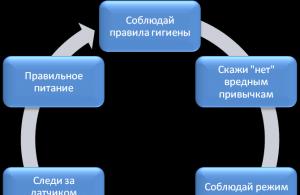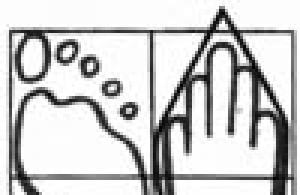ABS or anti-lock braking system- in the event of emergency, and sometimes regular braking, it prevents the complete blocking of the car's wheels, thanks to this system, the braking distance of the car is reduced, and during braking it becomes possible to drive the car due to the fact that the wheels are not blocked. During the operation of this system, you will surely hear a characteristic "crack" and a slight beating of the brake pedal.
EBD or brake force distribution- correctly distributes the braking forces of the front and rear axles of the car, the system is activated when the ABS does not work properly, indicated on the dashboard in the form of a red signaling device - "Brake failure".
BA or brake assist- this function reads how quickly you pressed the brake pedal, from the received data the system recognizes whether it was normal braking or emergency. In the event of emergency braking, the system will increase the pressure in the brake system drive to a certain level and will keep it as long as the brake pedal is depressed.
HHC or Roll Prevention on Hill Start- when the vehicle is stopped on an incline of four percent or more, the HHC system is activated to help the vehicle start moving further, for the HHC to work properly, depress the brake pedal with sufficient force to keep the vehicle in place after shifting into gear, releasing the brake pedal and depressing the accelerator pedal, the system will hold the vehicle in place until it starts to move, but no more than two seconds. The system is automatically deactivated if the car is parked or the driver's door is opened.
ESC and TC - or stability control and traction control- these two car functions work in pairs and are activated automatically when the car engine is turned on. ESC is responsible for the reliable stability of the car on the road, the system reads the speed of rotation of all wheels, and if one or more of them start to rotate faster, the system slows down their rotation, in more serious situations, the system slows down the engine speed, due to which it returns the controllability of the car. TC performs the same functions as ESC only when starting the vehicle, which reduces excessive wheel spin of the vehicle.
|
Active vehicle safety includes electronics to prevent accidents. Lada Vesta is equipped with many such assistants that help to maintain controllability of the car when traveling. Among other things, the driver should know how the Lada Vesta traction control system works.
For the movement of the car, traction is important. But its reliability drops dramatically if the road is wet or slippery, which increases the likelihood of slipping. It causes problems such as:
- loss of dynamics during acceleration;
- poor controllability;
- high probability of skidding;
- increased tire wear.
The stability control system on the Lada Vesta works in conjunction with traction control (TCS), which allows the driver to move off on a slippery surface with a minimum chance of slipping.
In fact, it looks like this: if the wheel starts to rotate too fast during acceleration, the slip system works and takes corrective measures: braking or reducing the transmitted torque. The car, however, remains stable.
On a note!
On Lada Vesta, antibuks works in all trim levels.
How to disable traction control
TCS turns on immediately after starting the engine. Shutdown is possible together with ESC. To do this, press the button on the center console. There is no separate shutdown.
Reliability of TCS on Lada Vesta
Each vehicle stabilization system was tested under various road conditions (wet asphalt, slush, ice, etc.). The TCS traction control system has shown its best side: it “intervenes” only when necessary and works perfectly with other electronics.
The owners are also mostly satisfied, although it took some time to adjust to all the Vesta's functionality.
On a note!
It is better to think several times before turning off the TCS. Electronic security systems, including Lada Vesta anti-bux, increase your chances of a successful outcome of a dangerous situation on the road. Yes, and under normal driving conditions, you can feel more confident knowing that there is such a safety net.
The safety of the car at the present time is put in first place among all other categories. Inside a foreign car, you can observe about two dozen various options that are responsible for the life of the owner. Many are interested in how the Lada Vesta traction control system works. The analysis of its activities was carried out by professionals on numerous tests.
On a note!
The slip mechanism has different abbreviations (TRC, DTC, TCS, ESP), which refer to the respective car models. Cars are equipped with a system from a certain company, which try to equip products with suitable and specific elements as much as possible. Due to this, sufficient efficiency and safety when driving are achieved.
Characteristics of Traction control system and principle of operation
Receiving a signal from the indicators that are mounted on the wheels, the TCS traction control system, using the built-in electronic unit, monitors the speed of rotation of the disks. If there is a sharp increase in the speed of rotation of one of the wheels, the TCS does its best to reduce traction and establish a stable balance. At the same time, the braking function is activated by electro-hydraulic actuators.
On Lada Vesta, antibux works as follows:
- the option is indispensable on a wet road surface and in other circumstances that entail insufficient traction;
- using the data received from the sensors, the stabilization system knows about the speed of the torque and corrects the indicators in time through the electronic system;
- traction control Lada Vesta significantly raises the level of balance when entering a turn;
- antibuks starts to work in high gears, not all owners like inappropriate help with a sharp start.
Most modern models have the function of turning off this assistant on the roads. However, experts strongly restrict owners from such a decision, since the option significantly increases the chances of staying on the road surface, and not flying out of it. Disabling APS Lada Veste does not make sense.
How to disable traction control on Lada Vesta
Considering that this braking modification is controlled by a computer system, the shutdown is accompanied and regulated by it. A lot depends on the make of the car. The start of the TCS occurs simultaneously with the start of the vehicle engine. The stability control system on the Lada Vesta is deactivated by pressing a special button on the dashboard.
The Lada Vesta traction control system greatly simplifies driving. This must be remembered by every motorist and have high hopes for this modification, since in difficult weather conditions it can save the lives of both the driver and passengers.
abbreviations
Questions & Answers
abbreviations
ECU (Electronic Stability Control System). see ESC
ESC (Electronic Stability Control) - Electronic stability control.
ESP ® (Electronic Stability Program) - BOSCH Electronic Stability Program. See ESC.
ABS (Anti-lock Braking System) - Anti-lock braking system
An automated system that prevents the car's wheels from locking in the event of braking. The main task of the system is to ensure the controllability of the vehicle during heavy braking.
ASR (Antriebs Schlupf Regelung) - Anti-slip system(APS)
A logical continuation of the development of the anti-lock braking system ABS. This system greatly simplifies driving on a wet or wet track. See TCS
TCS (Traction Control System) - Traction Control / Traction Control System
An electro-hydraulic vehicle system designed to prevent loss of traction by controlling the slip of the drive wheels. It is activated when one of the drive wheels tends to slip.
BAS (Brake Assist System) - Emergency brake booster
The system is designed to help with extreme braking. Works in conjunction with ABS and EBD systems. The system evaluates the speed with which the brake pedal was pressed, other sensors record the speed of rotation of the wheel and the speed of the car. If the speed is high and the brake pedal is pressed very quickly, then the BAS system forces the brakes to work at full power, but without blocking the work of the ABS.
HSA (Hill Start Assist) - Hill start assist
Facilitates starting by maintaining brake pressure for about 2 seconds after releasing the brake pedal. The driver has enough time to transfer the foot from the brake pedal to the gas pedal without using the handbrake. The car calmly moves away without rolling back, which greatly increases the comfort and safety of driving.
TPMS (Tires Pressure Monitoring System) - Tire pressure monitoring system
Designed to warn of a dangerous change in tire pressure. A drop in tire pressure results in a change in wheel speed. By comparing wheel speeds, a potentially blown wheel is identified. This optional feature allows you to monitor tire pressure without using tire pressure sensors.
HBA (Hydraulic Break Assist) - Hydraulic brake booster
The hydraulic brake booster recognizes the threat of emergency braking by monitoring the position of the brake pedal and the pressure gradient. If the driver does not brake hard enough, the hydraulic brake booster increases the braking force to the maximum. The braking distance is shortened.
EBD (Electronic Brake Distribution) - Electronic brake force regulator
The brake force distribution system is designed to prevent the rear wheels from locking up by controlling the brake force. When the car brakes hard, there is an additional reduction in the load on the rear axle, as the center of gravity shifts forward. And the rear wheels, at the same time, may be blocked.
Questions and answers
What do I need ESC for?
At least 40% of all road traffic deaths are the result of skidding. Studies have shown that ESC can prevent up to 80% of all skid accidents.
What is the difference between ESC and ESP® ?
The principle of operation and the effect of all dynamic stabilization systems in terms of traffic safety is the same. The difference is only in the name and manufacturer of these systems.
How does ESC work?
The ESC uses a number of smart sensors to detect loss of control. The system with a frequency of 25 times per second compares the trajectory set by the driver with the actual one. If they do not match, and if the car becomes uncontrollable, ESC is activated. Engine power is reduced to restore vehicle stability. If this is not enough, the system additionally brakes individual wheels. The resulting turning motion of the vehicle counteracts the skid. Within the limits of physical capabilities, the car maintains directional stability.
Is it possible to retrofit a car with an ESC system?
No. ESC cannot be installed on a machine where it was not. Therefore, when buying a car, make the right decision from the very beginning.
Do I need to turn on ESC when starting the engine?
No. The system is always active when the engine is running. Some models are equipped with an ESC switch. Pressing it will normally deactivate the TCS (Traction Control System) while the functions of the electronic stabilization program are retained. Shutdown is signaled by a control lamp on the panel of devices.
Do I need to change my driving style when driving with ESC?
No. You don't need to change your driving style. ES simply supports the driver in critical situations - when there is a threat of skidding. However, you must always be alert and use caution on the road.
Is ESC different from anti-lock braking (ABS) and traction control (TCS)?
The ESC combines all ABS and TCS components, with the added benefit of dynamic vehicle stabilization. By preventing the wheels from locking, ABS keeps the vehicle under control in the event of emergency braking. TCS prevents wheel spin during hard acceleration, providing optimal traction. While ABS and TCS work in the fore/aft direction, ESC helps counteract lateral movement that causes skidding.
Skidding is one of the main causes of severe accidents. Wet road surfaces, sudden sharp turns or obstacles that suddenly appear on the road, forcing the driver to make sudden maneuvers or brakes, greatly increase the risk of skidding. And this applies even to experienced drivers.
It is responsible for the directional stability of the car, preventing it from side sliding, skidding and rotation when the driver, due to lack of time or experience, cannot perform the necessary maneuver on his own. As a result, the car always remains on the trajectory chosen by the driver.
The ESC system combines the functions of ABS and TCS, and also provides vehicle stability control. The system helps the driver in any traffic situation. It detects the risk of a rollover and applies individual wheel braking or reduces engine power to restore vehicle stability.
Electronic Stability Control (ESC):
Does not leave a skid a single chance
Support in critical traffic situations
Loss of control when cornering
The driver was speeding, which forced him to brake sharply in a sharp turn.
In a normal situation, the car, under the influence of inertia, would have to slide onto the side of the road.
The ESC brakes the rear wheel on the inside of the turn, reducing the radius of travel and allowing the car to safely enter the turn.
A sudden obstacle
If an obstacle suddenly appears, emergency braking may not be enough. To avoid a collision, the driver needs to brake and perform an evasive maneuver at the same time.
Since the wheels of a car without ESC are blocked, the car stops responding to steering turns and it becomes impossible to evade a collision with an obstacle and the car breaks into a skid.
The ESC system brakes the front wheel moving along the outer turning radius and the car confidently goes around the obstacle.
Security Anniversary
BOSCH is celebrating another anniversary. 2015 marks the 20th anniversary of the development and implementation of the ESP® vehicle electronic stabilization program.
The company's success story began in 1978 when it was the first in the world to create and commercialize ABS, an electronically controlled anti-lock braking system that became the basis for all the following active safety systems.
In 1986, it was followed by the ASR / TCS traction control system,
and in 1995, the ESP® / ESC electronic stabilization program.
Already since 2009, BOSCH together with AVTOVAZ has been implementing a program in our country to popularize active car safety systems among Russian motorists.
Today, the LADA Granta and LADA Kalina models are produced, which are equipped with an electronic stability control (ESC) system.
For LADA Vesta, the ESC system will include
in all basic configurations.
HOW ESC WORKS
The ESC system is active all the time. The sensor signals are processed by a microcomputer, which checks at a frequency of 25 times per second whether the driver's control efforts correspond to the actual direction of travel. If the vehicle is moving in the other direction, the system recognizes a critical situation and reacts immediately – independently of the driver.
To return the car to a given trajectory, the braking system is used here. Thanks to the selective braking of individual wheels, the system creates the necessary reaction force, and the car behaves as the driver wanted.
The ESC system not only initiates brake intervention, but can also cause the engine to accelerate the drive wheels. Thus, within the laws of physics, the car is reliably kept on a given trajectory.
Communication with
engine control unit
The ESC control unit communicates with the engine control unit via the data bus. In certain situations, it can reduce engine torque when the driver presses too hard on the gas pedal. It is also possible to compensate for excessive slip of the drive wheels caused by the braking torque of the engine.
Steering Angle Sensor
Determines the position of the steering wheel. Based on the steering angle, vehicle speed and brake pressure or accelerator pedal position, a driver-specified trajectory is calculated.
Wheel speed sensor
The control unit uses the information from the wheel speed sensors. The sensor is non-contact and measures the speed of rotation of the wheels through a magnetic field. It can determine the direction of rotation and the stationary state of the wheel.
ESP® recognizes a critical situation and reacts immediately – regardless of the driver
Hydraulic unit with control unit
For those who do not know what kind of animals these are: ABS and ESP.
The ABS system is an anti-lock braking system that is able to counteract wheel spin during braking maneuvers - this is necessary to ensure greater driving safety.
The ESP system is a directional stability solution designed to prevent the car from skidding (the necessary wheels are braked, this is controlled by the electronic unit). By the way, ESP itself without ABS is absolutely useless, because it is, let's say, a makeweight to it.
How does Vesta behave on ice with ABS and ESP?
We decided to test Lada Vesta in the winter time - it is interesting how the operation of the above systems will behave. For testing, we chose an ice range 700m long. It was important for us to find out in which cases the system will perform badly, and in which cases it will be good. For greater stability, we equipped the test specimen with Nokian tires.
Typically, such tests begin by turning off both systems. This is not surprising - after all, it is important for us to know how a “naked” car behaves on ice. To disable ABS + ESP, you will need to remove the voltage supply - namely, remove the fuse responsible for their operation. If you don’t pull it out, then no matter how much you poke your finger into the ESP off button, the on-board electronics will force it on anyway at speeds above 50 km / h.
So, let's start, since good studded tires help to start off the ice. We see a turn, we try to fit into it - at the same time we feel that the car is starting to skid. The front wheels confidently hold the grip, but the rear is unstable - however, nothing critical.

A motorist with experience will overcome such a small skid without much difficulty by pressing down on the accelerator pedal - fortunately, the landfill allows this. The fact that the car drives very confidently even on icy surfaces is definitely pleasing - at the same time, the quality of control does not suffer, Vesta clearly responds to the slightest rotation of the steering wheel, gently turns, does not wriggle while moving along an arc.

We stop and turn on the anti-lock and directional stability systems. We start up and hit the road again - while the car practically does not suffer from a loss of dynamics.

Once again, excellent wheels help us out. In this case, ESP + ABS do not respond immediately to changes in driving conditions.

Most likely, problems will begin only with the total drift of the car. If you get into a real side drift, electronics are unlikely to help you out. In such a situation, the driver may not save the situation, because the on-board electronics will already control the fuel supply - no matter how much you press the gas, you will not get an adequate response from the car.

RESULTS:
Summing up the above, we can safely say that with the directional stability and anti-lock systems turned off, Vesta showed the time to complete the track 8 seconds faster than when ABS and ESP were turned on. As it is easy to assume, this result is due to the fact that the included systems somehow prevented the actions of the driver, wasting valuable time evaluating the responses of various sensors. However, during an ordinary trip on an icy road, the systems, on the contrary, will only help when driving, preventing loss of course and drifts.
How to ride - with or without ASB + ESP, it's up to you. Only the driving style and your driving experience influence this decision.
Cuvette test Lada Vesta with and without ESP
The winter road promises many hidden dangers. Often the right side of the curb looks like a snow-covered flat surface. However, a very large number of motorists who, for one reason or another, must go to it, with annoyance (and, alas, belatedly) fall into a real ditch, covered with a seemingly horizontal layer of snow.

Our new Lada Vesta test is designed to find out what advantages the ESP system provides, just designed to control the distribution of vehicle forces in difficult situations. For greater clarity, we decided to move into a ditch and try to get out of it, first without a course stabilization system, and then using it.
Let's just say, the car had to work hard. She balanced almost in a dangling state with two wheels on the edges of the ditch - in this case, as a rule, it is almost impossible to do without outside help. But we dare to assure you, the factory electronics did not let us down. The onboard "brains" precisely dosed the injection of gasoline, allowing not only to let the car stand up straight, but also to climb onto the opposite side of the ditch, returning to the roadway.
Recall that we performed all the above maneuvers with the ESP system involved.

Next, we disabled ESP. In this case, no attempts and tricks to move the car from an uncomfortable position were unsuccessful. The wheels of the front axle only bit into the snow and ice harder and harder. In such a situation, it is possible to leave the ditch only with great luck or with outside help.
RESULTS:
The test results revealed a clear benefit provided by the ESP system on Lada Vesta. This applies to both smooth road surfaces and roads with poor traffic. In general, the presence of an electronic stability control system will be a great help to both novice and experienced drivers - after all, when they want to help you, is it worth refusing?
We test Lada Vesta for climbing uphill with the electronic stability control system turned on and off
AvtoVAZ developed Lada Vesta for operation in the city. But sometimes it happens that cars sometimes have to leave the city, and it's no secret that the road surface outside the metropolis may contain potholes, holes and other irregularities.
New testing for Lada Vesta took place on a special track, which helped us to figure out how best to overcome hill climbs - with or without ESP.


 Photo "b"
Photo "b"







